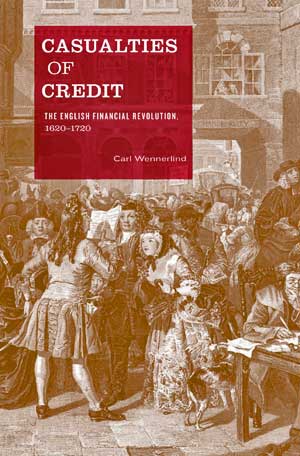
Casualties of Credit offers a cultural history of early modern money. In exploring the intellectual underpinnings of the seventeenth-century English Financial Revolution, I uncover how people conceived of money and how their understanding was grounded in the prevailing thinking about science, philosophy, politics, commerce, law, and colonialism. While Casualties of Credit’s most immediate focus is on a series of unexpected connections between money and alchemy, slavery, and the death penalty, its more general aim is to illuminate the deep cultural and political embeddedness of credit. Moreover, I also explore the tension between credit’s marvelous productive potential and the integral role repressive violence played during the Financial Revolution.
I begin the book by arguing that the Scientific Revolution played a central role in the epistemic turn that paved the way for the development of a radically new culture of credit. In particular, I focus on how the Hartlib Circle—the period’s premier scientific and social reform group—embraced Baconian and alchemical thinking in developing a vision for the universal reformation of humanity. Armed with proper knowledge, they believed that it was possible for mankind to transmute nature, society, and people for utilitarian ends—and thus launch what they referred to as an “infinite improvement” process.
Money played an essential role in the Hartlibian reform project. But for money to be able to ignite industry and activate hidden resources, as well as mediate an ever-expanding world of goods, it was necessary to find a way to expand the quantity of money in society. After discussing how the Hartlib Society ambitiously sought to use their alchemical knowledge to turn lead into gold, I explore how they switched their attention to the development of a generally circulating credit currency once their transmutational efforts failed. Moving from a metallic currency to a paper currency did not strike them as that great of a leap considering their understanding that all forms of money are based on credit. Trust, not materiality, was thus the most essential ingredient in money. While silver and gold had successfully enabled trust in the past, the Hartlibians argued that value-less paper notes could also operate as money, granted they fulfilled certain criteria.
Casualties of Credit then proceeds to explore the ideas and practices associated with the formation of trust. Drawing on new models for probabilistic thinking developed by John Locke and other philosophers, political economists derived a set of principles for how to create the most confidence-inducing currency. In addition to solid assets securing the paper notes, transparent institutional designs and accounting practices, and honest and honorable directors, one of the most important conditions for the development a credit currency was that anyone who undermined trust and confidence was harshly punished. In exploring how these criteria informed the creation of the Bank of England in 1694, Casualties of Credit turns to its second primary focus: the role of violence in the English Financial Revolution.
The rest of the book engages with the debates surrounding, firstly, the use of the death penalty to protect the new credit currency against forgers and counterfeiters and, secondly, the initiative to use anticipated profits from the African slave trade to bolster trust in the nation’s public credit. In both instances, repression and violence played essential roles in protecting and promoting trust in the new culture of credit. While John Locke, Christopher Wren, and Isaac Newton played prominent roles in the debates about the use of the death penalty against monetary criminals, Daniel Defoe and Jonathan Swift actively and enthusiastically promoted the scheme to use profits from the slave trade to bolster public credit.
Ever since enrolling in a PhD-program in Economics, I have been troubled by the excessive abstraction whereby economists treat money. While past thinkers, from Aristotle and Plato to Karl Marx and John-Stuart Mill, sought to capture the multifaceted role money plays in society, modern economists from Karl Menger and Alfred Marshall have been content with exploring money’s exclusively economic functions. Now, as a historian, most of my writings to date have been dedicated to illuminating the interactions between money’s economic, social, political, and moral meanings. Whether discussing the semiotics of money or the role of money in the Scottish Enlightenment, I have tried to capture the complex ways in which money mediates interactions between people and classes. Moreover, contrary to economists, who most often view the development of money as a natural and teleological process, I follow in the tradition of scholarship that understands money as a constructed, contingent, and contested social institution.
Casualties of Credit brings this perspective to bear on a particularly important moment in the history of money when England developed Europe’s first system of credit money. The emergence of this new currency had deep roots in a series of important, at times seemingly unrelated, concurrent historical developments, such as the development of the modern fiscal-military state, the birth of England’s two-party system, the emergence of a public sphere, expansion of world trade, colonization, enslavement, the Scientific Revolution, and a new political economic discourse. I argue that all of these changes produced a new zeitgeist or worldview, in which society and its constitutive institutions were perceived radically different from before. Absent this new intellectual culture, it is unlikely that the Financial Revolution would have occurred when and where it did. Ideas, I argue, thus played an important role in the conception, implementation, and maintenance of the new culture of credit.
While chapter four, dealing with the debates surrounding the use of the death penalty for counterfeiting crimes, offers some revealing examples of how contemporaries understood money politically, I would steer the “just browsing” reader to chapter six, in which I discuss how the South Sea Company was created to rescue the national debt with the revenues expected from its newly acquired monopoly on the slave trade to Spanish America. In addition to uncovering a lesser-known tie between money and slavery, this discussion highlights credit’s capacity to obfuscate its underlying social relations in a manner that differs from that famously described by Marx as money fetishism. Marx argued that money has a tendency to hide the social conditions wherein value is created. This allowed an early modern Londoner to sip a porcelain cup of sweetened coffee, while enjoying a smoke of tobacco, paid for with a silver coin, without acknowledging the horrid conditions laborers across the globe endured in the production of these luxuries. I argue that credit fetishism constitutes a higher degree of abstraction. Since credit—in this case the credit issued by the South Sea Company’s engagement with the slave trade—is based on carefully calculated projections of future earnings, investors are more consciously concerned with the source and conditions of value formation. This was certainly the case during the inception of the company, when the public discourse engaged nearly all conceivable opportunities and threats associated with the scheme. Yet, despite carefully imagining the future of the slave trade, both proponents and opponents of the scheme completely ignored the agency, subjectivity, and mortality of the slaves. Even though the lack of attention to human suffering did not constitute a deliberate choice on the part of London investors trading shares in the coffee houses of Exchange Alley, it was nevertheless a more active and selective abstraction than the more universal blind-eye towards the social relations of production that Marx’s concept of money fetishism entailed.
Casualties of Credit is an effort to explore both the positive and negative features of the early modern culture of credit. On the one hand, I point to the impressive achievement of humanity to generate such a complex system based on trust and credit’s incredible productive capacity that the Financial Revolution unleashed, without which modern material marvels would not have been possible. On the other hand, I also highlight the integral role played by authority, violence, and suffering during the early phases of modern financial capitalism. As David Graeber has pointed out in a wider time frame in his Debt: The First 5,000 Years, credit is both a remarkable human accomplishment and a social institution marred in violence and suffering. In exploring this janus-faced quality of credit, I also seek to bring the liberal and radical scholarly traditions into conversation with each other, drawing for example on the writings of both J. G. A. Pocock and Peter Linebaugh.
My book is also a contribution to the recent efforts of historians and anthropologists to regain some of the analytical terrain ceded to economists. While economists have exhaustively explored the economics of finance, a growing number of historians and anthropologists have recently rediscovered that there are many politically and analytically salient features of credit that are simply ignored by economists. To better understand the origins, workings, and future of capitalism, we need both the social sciences and the humanities to contribute to our understanding.
Casualties of Credit also highlights the importance of ideas to the Financial Revolution and to the development of capitalism more broadly. While Joel Mokyr has recently showed in his book The Enlightened Economy that ideas mattered greatly for the English Industrial Revolution, my book suggests that ideological conflicts, intellectual debates, and political schisms played central roles in the development and configuration of the new culture of credit. Moreover, drawing on the work of Mary Poovey on the relationship between the imagination and credit, I offer some analytical consequences of viewing credit as unrestricted in time and space, capable of moving wherever the imagination goes. I show how credit can be used as a valuable lens through which to study capitalism, in that it reveals important connections between seemingly independent and disparate phenomena.


Carl Wennerlind, an Associate Professor of History at Barnard College, Columbia University, specializes in early modern European history, with a focus on intellectual history and political economy. He is particularly interested in the historical development of money and credit, as well as attempts to theorize these phenomena. He lives in New York with his wife, Monica L. Miller, and his two children, Langston and Selma.